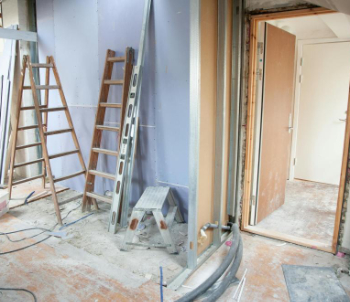Over-engineered buildings obstruct efficiency
Assuring technical compliance and meeting building codes is one thing, yet designing a building’s M&E systems to have more electrical, heating and cooling capacity than is needed, costing more and driving higher energy consumption is another! To create spaces which hit the mark on efficiency, quality and comfort, what smarter considerations can be utilised to ensure building services perform as designed and maintain a thermally comfortable environment for occupants?
Contents |
[edit] Introduction
Over-engineering has a significant impact on the cost and performance of a building project or scheme, particularly in terms of efficiency. Signs of over-engineering can manifest themselves in a variety of ways; from plant cycling to uncomfortably warm spaces, to slow pump speeds and stop-start chillers. These inefficiencies have a draining effect on a building’s performance and occupant comfort, and can also negatively impact a building’s green credentials.
[edit] Over-engineering: what is the deal?
Over-engineering can occur for many reasons, but the majority of the time it can be as a result of human behaviour. We are, arguably, predisposed to err on the side of caution when there is a certain degree of risk. Where there are ambiguities human beings will over-compensate, just to be sure they have shielded themselves against anything that has the potential to cause any damage. The same can be said for construction projects; under-designing is known to affect companies’ insurance claims, so for engineers it is no wonder they make certain concessions, giving a 20% leeway just to be sure.
This leeway however, isn’t something done arbitrarily but grounded in the building regulations. Publications such as the 18th edition of the New Wiring Regulations, known as BS 7671, published by the Institution of Engineering and Technology (IET), recommends an additional 20% capacity for future uses. Whilst this capacity has been enshrined in building regulations, its implication on over-engineering is problematic. The extra capacity currently implies that electrical networks are being designed 20% larger than they need to be and based on potential forecasts. By project completion, if we apply this principle to all building services, these incremental increases create a massively over-engineered building that could be avoided if exact figures were ascertained. At the moment this current practice is resulting in high degrees of inefficiency.
To challenge this systemic issue, change must come from within. Some degree of commonality needs to be identified so designers can make their calculations with as much reliability and accuracy as possible.
[edit] Overcoming over-engineering
One of the options which has the potential to combat over-engineering is data. The built environment sector’s digital maturity is developing day-by-day, with more and more companies finding they now have the appetite to utilise different technologies.
There is certainly the culture available to make data sharing a viable solution to over-engineering. For the very first time we are seeing the GLA (Greater London Authority) request the data capture of meters to accurately benchmark the schemes that are being implemented in a specific area. Should this be successful, the sector will be able to learn from this and see the real-time electrical performance of a building.
To highlight data’s benefits, let us take an example. On a residential high-rise development comprising 400 flats, from the initial calculations it is clear the development requires 1000kw of electrics. But what if designers had access to meter data from previous developments? Would this visibility enable them to make more accurate predictions? If there was, for instance, the data to monitor the actual use over the course of three years, it might show us that only 600kw is being demanded. Consider the extent in which this would help designers to anticipate expected loads with greater confidence and reliability. Even the smallest change in pipework length or cable size has a knock-on effect on a building’s entire system; from the insulation, to the clips, weight and strength or screws, pump size, and standing heat loss. The list goes on. If we make use of data sharing, engineers could design products more efficiently.
The data could then be used as an education tool – to learn from previous projects in order to improve future ones. With data access, designers will be able to ask themselves what could they have done better; if the electric or heating load is accurate, and whether anything else could have been executed to make a product more efficient. The visibility and traceability which data provides would greatly reduce the likelihood of over-engineering, as engineers are able to gauge the predicted energy usage from data that is shared by the electrical supplier.
[edit] How to make it a reality?
Whilst EPCs are a prerequisite for all buildings, we need to make sure there is the interest and incentive to roll-out this approach to all areas of the industry. In order for this to be delivered across construction efficiently and professionally, legislation would have to be put in place as opposed to advisories. The data would also have to be held in a central repository that is secure; either stored on an online library or made accessible through a reputable industry body. Once it is available the data would have to be listed in the design standards such as CIBSE, IET and the electrical design manuals so the design standards reflect the benchmarks.
Whilst there are many ways to overcome over-engineering, the utilisation of data will undoubtedly enable designers to have more clarity when it comes to ascertaining how a building performs. If the data is able to capture the actual loads once a building is in use, consider the vast difference it will make to the way engineers consider a scheme’s electrical network. It will offer more reliability for the designers and better value for their clients, and will greatly improve the overall efficiency of a building once it is in use.
This article originally appeared in CIAT’s AT Journal, Issue 140 - Winter 2021. It was written by Alex Hill, Managing Director, Whitecode Design Associates.
--CIAT
[edit] Related articles on Designing Buildings
Featured articles and news
Considerate Constructors Scheme acquires Building A Safer Future
Acquisition defines a new era for safety in construction.
AT Awards evening 2024; the winners and finalists
Recognising professionals with outstanding achievements.
Reactions to the Autumn Budget announcement
And key elements of the quoted budget to rebuild Britain.
Chancellor of the Exchequer delivers Budget
Repairing, fixing, rebuilding, protecting and strengthening.
Expectation management in building design
Interest, management, occupant satisfaction and the performance gap.
Connecting conservation research and practice with IHBC
State of the art heritage research & practice and guidance.
Innovative Silica Safety Toolkit
Receives funding boost in memory of construction visionary.
Gentle density and the current context of planning changes
How should designers deliver it now as it appears in NPPF.
Sustainable Futures. Redefining Retrofit for Net Zero Living
More speakers confirmed for BSRIA Briefing 2024.
Making the most of urban land: Brownfield Passports
Policy paper in brief with industry responses welcomed.
The boundaries and networks of the Magonsæte.
London Build Fire and Security Expo
20-21 Nov and now with new Ambassador Programme..
The Scottish Building Safety Levy
Eight weeks of consultation closing on 18 November.
The grey, the brown and the golden rules of housing
shifting policies from the wild west of housing development.
Future proofing homes that are fit for purpose
Specification challenges and the role of plastic.
Thousands of new homes unlocked for brownfield sites
£68 million to 54 councils for neglected land into new homes.

























